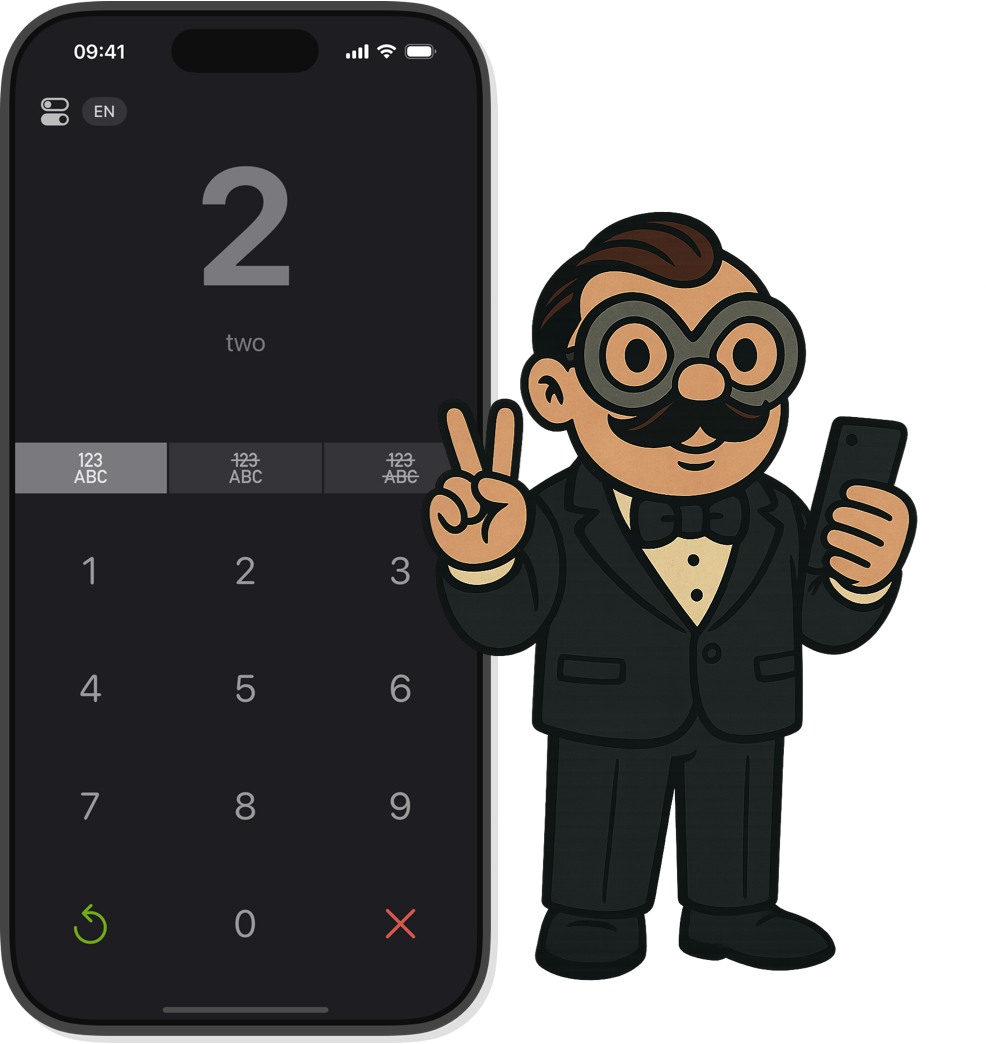Korean Numbers Made Simple
Learn Korea's two number systems: We explain both Sino-Korean and Native Korean numbers – with rules, numbers 1–100, and practical tips for daily life, travel, and language learning.


How Korean Numbers Are Structured
Korean uses two parallel systems: Sino-Korean numbers and Native Korean numbers. Sino-Korean originates from Chinese, is highly regular, and is used for money, dates, phone numbers, and most numeric information.
- 1-10
-
Basic numbers: 일 (il), 이 (i), 삼 (sam), 사 (sa), 오 (o), 육 (yuk), 칠 (chil), 팔 (pal), 구 (gu), 십 (sip)
These vocabulary words are the foundation for all other numbers.
- 11-19
-
Formation: 십 (sip) + ones digit
Numbers from 11 to 19 are formed by adding digits 1-9 to 십 (sip, ten). For example: 11 is 십일 (sip-il, "ten-one") and 19 is 십구 (sip-gu, "ten-nine").
- 20-99
-
Formation: tens digit + 십 (sip) + [ones digit]
Tens numbers are formed by placing the tens digit before 십 (sip). For example: 20 is 이십 (i-sip, "two-ten"). Numbers like 21 or 99 simply add the ones digit at the end: 21 = 이십일 (i-sip-il, "two-ten-one"), 99 = 구십구 (gu-sip-gu, "nine-ten-nine").
- 100
-
백 (baek)
In Korean, the number 100 is expressed as 백 (baek).
- 0
-
Two words for zero: 영 (yeong) and 공 (gong)
영 (yeong) is used in mathematics and for temperatures. 공 (gong), which means "ball," is frequently used in phone numbers.
Two Number Systems in Korean
Korean relies on two systems side by side:
- Sino-Korean (한자어 수)
-
Used for dates (년/월/일), minutes/seconds (분/초), money (원), phone numbers, lines/floors (호/호선/층), school years (학년), months (월), measurements, math, and for 100+.
- Native Korean (고유어 수)
-
Use up to 99, mainly with counters, for hours (시), age with 살, and frequency (한 번/두 번/세 번). Short forms before counters: 하나→한, 둘→두, 셋→세, 넷→네, 스물→스무.
Korean Numbers from 1 to 100
All Sino-Korean numbers from 1 to 100 at a glance – with Hangeul. Perfect for systematic learning and quick reference.
Native Korean Numbers from 1 to 100
Native Korean numbers are used mainly with counters, for hours, age (살) and frequency. They practically end at 99 – 100 is Sino again: 백 (baek).
Test Your Korean Number Skills
Test your knowledge: Can you correctly match Sino-Korean numbers from 1-100? Give it a try!
Pro tip: App for targeted number training. Did you know there's an app dedicated exclusively to numbers in foreign languages? With the Numfred App, you can specifically learn Korean numbers and even adjust the grouping of large numbers: Instead of thousand grouping (10,000), you can switch the number display to myriads (1.0000). This matches the Korean counting system and makes learning large numbers much easier, especially when starting out!
Learn Korean numbers with the Numfred App!
The app designed to help you master listening comprehension for numbers in foreign languages.
- Free basic number ranges
- Learn numbers in 13 languages
- No subscription. No registration.
- Ad-free
Hundreds, Thousands and Large Numbers
In Korean, large numbers are formed very systematically in groups of four (based on 10,000), just like in Chinese. Here are the most important units:
- 100
-
백 (baek)
The number 100 is expressed as 백 (baek). It continues with the same pattern: 이백 (i-baek) for 200, 삼백 (sam-baek) for 300, etc.
- 1.000
-
천 (cheon)
The number 1,000 is expressed as 천 (cheon). Thousands only go up to 9,000; from 10,000 onwards, the counting system begins with 만 (man).
- 10.000
-
만 (man)
From 10,000 onwards, Korean uses the unit 만 (man). For 10,000, you don't say ten times thousand, but rather one man (일만).
- 1.000.000
-
백만 (baek-man)
One million is expressed as 백만 (baek-man), which means one hundred times ten thousand.
- 100.000.000
-
억 (eok)
The unit 억 (eok) represents 100 million. Example: 300,000,000 = 삼억 (sam-eok).
- 1.000.000.000
-
십억 (sip-eok)
One billion is expressed as 십억 (sip-eok), which means ten times one hundred million.
Which System to Use When?
A quick decision guide for everyday use:
-
Sino-Korean:
Dates (년/월/일), minutes/seconds (분/초), money (원), phone numbers, lines/floors (호/호선/층), school years (학년), months (월), measurements, math, 100+. -
Native Korean:
Hours (시 → 한 시, 두 시 …), age with 살 (e.g., 스무 살), counting with counters (개/명/마리/권/대/잔/병 …), frequency (한 번/두 번/세 번).
Common Pitfalls When Learning Numbers
Even though Sino-Korean numbers are logical, there are some tricky aspects:
-
Counter words:
Korean requires special counting words. You can't simply say "three floors". It's: 삼 층 (sam cheung). Sino-Korean numbers are used for floors, months, amounts of money, among others. -
Short forms before counters:
Use 한, 두, 세, 네 and 스무 instead of 하나, 둘, 셋, 넷, 스물. Examples: 세 시, 두 개, 스무 살. -
Native numbers cap at 99:
For 100 and above, switch back to Sino-Korean (백, 천, 만 …). -
Time (hours):
Hours use Native Korean; minutes use Sino-Korean.
세 시 반 = 3:30 (se si ban)
다섯 시 십 분 = 5:10 (daseot si sip bun) -
Age (살):
스무 살 = 20 years (seumu sal)
스물다섯 살 = 25 years (seumul-daseot sal) -
Lucky & unlucky numbers:
The number 4 (사 sa) is considered unlucky because it sounds like "death." Often the 4th floor is skipped in buildings (sometimes labeled as "F" Floor). -
Age: 살 vs 세:
Everyday speech often uses 살 (Native: 스무 살), while formal/official contexts use 세 (Sino).
Understanding and Using Numbers in Daily Life
In Korean, you'll encounter Sino-Korean numbers everywhere – here are the most important use cases:
-
Phone numbers:
Each digit is spoken individually: 010 1234 5678 = 공일공 일이삼사 오육칠팔 (gong-il-gong il-i-sam-sa o-yuk-chil-pal) -
Prices & money:
Currency is Won (원).
10,000원 = 만 원 (man won)
7,500원 = 칠천오백 원 (chil-cheon-o-baek won) -
Dates & time:
Year, month, day, minute and second are given with Sino-Korean numbers.
2025년 8월 15일 = 이천이십오년 팔월 십오일 (i-cheon-i-sip-o-nyeon pal-wol sip-o-il)
30분 10초 = 삼십 분 십 초 (sam-sip bun sip cho) → 30 minutes, 10 seconds -
Quantities (in certain contexts):
Restaurant portions are often ordered with Sino-Korean numbers.
3인분 (sam inbun) = three portions
5호선 (o hoseon) = Line 5 (subway)
Additionally, very common with Native + counters: 사과 다섯 개 (five apples), 학생 두 명 (two students), 고양이 세 마리 (three cats), 책 네 권 (four books). -
Frequency (번):
한 번 = once, 두 번 = twice, 세 번 = three times -
Basic arithmetic:
3 + 3 = 6 → 삼 더하기 삼은 육 (sam deohagi sam-eun yuk)
10 - 4 = 6 → 십 빼기 사는 육 (sip bbaegi sa-neun yuk)
5 × 5 = 25 → 오 곱하기 오는 이십오 (o gobhagi o-neun i-sip-o)
12 ÷ 4 = 3 → 십이 나누기 사는 삼 (sip-i nanugi sa-neun sam) -
Fractions & decimals:
¼ = 사분의 일 (sabun-ui il)
½ = 이분의 일 (ibun-ui il)
0.8 = 영점팔 (yeong-jeom-pal)
Unique Features of Korean Numbers
Korean has some unique characteristics when handling Sino-Korean numbers:
-
The 10,000-based system:
Like Chinese, large numbers are counted in groups of four. 10,000 is called 만 (man), 100 million is called 억 (eok). Example: 120,000 = 십이만 (sip-i-man), literally "twelve-ten thousand". -
Hanja number characters:
Sino-Korean numbers derive from Chinese characters (Hanja). Sometimes you still see these on official documents or historical texts: e.g., 一 (일), 二 (이), 三 (삼). -
Cultural significance of numbers:
The number 4 (사 sa) is often avoided because it sounds like "death." Numbers 3, 7, and 8, on the other hand, are often considered lucky numbers in Korea.
Explore More Languages:


